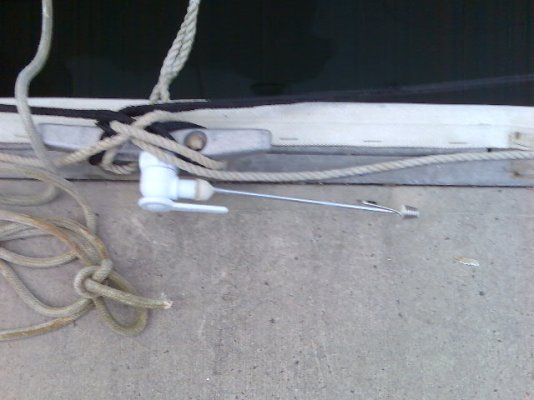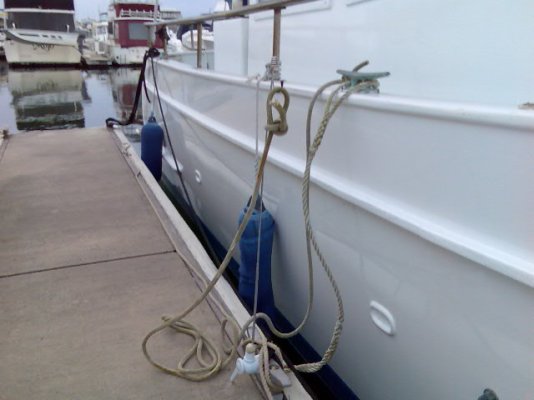But how do you get off a face dock with a boat in front and behind you when the wind is blowing hard on your beam blowing you against the dock?
Here's whart we do and it works every time. After removing the fore and aft springs, we unfasten the bow line and take it around a cleat or the bullrail next to the bow. One of us, usually my wife, stands on the foredeck at the rail and takes the bitter end of the bow line and holds us in place. The other person removes the stern line and gets aboard. The engines are already running, everything's ready to go.
My wife is also holding one of our really big fenders that we carry for just this maneuver so it is in place where she thinks the bow might contact the dock. She's holding it rather than tying it off so she can move it quickly if necessary
I put the wheel hard over toward the dock, the dockside transmission in reverse and the ourboard transmission in forward. The combination of the combined propwalk of both props and the thrust of the outboard prop against the hard-over rudder behind it moves the stern out quite smartly. But the bow can't go anywhere, forward or backwards, because of the bow line my wife is holding. There is little fore or aft force anyway becasue the two props are cancelling each other out in terms of moving forward or backwards. So it's not like she has to hold onto the bowline with all her strength to keep the boat from moving forward or backwards.
Meanwhile with her other hand she positions the fat fender betrwen the bow and the dock since the bow will be pivoting in as the stern pivots out. So the end result is the bow stays put while the stern swings out like a gate on a hinge.
I always swing the stern out more than it looks like I need because as soon as you start backing out the wind is going to push that bow in toward the dock and I don't want it to swing down and hit the boat behind us as we back clear. So I estimate I swing the stern out about 60 or 70 degrees before tellng my wife to "cast off" and backing away.
The windier it is the more power we'll use.
Once the stern has swung out as far as I want it I put both transmissions in reverse, center the rudder and back out, quickly if necessary. My wife slacks off on the bow line, picks up the line where it exits the hawse, lets the bitter end go and pulls the whole line in around the cleat or bullrail and back on board.
And that's it. We're well clear of the dock and we've used no more space than the length of our boat to do it.
We use this method to get off a dock every time unless we're at the end of the dock and can back or go forward straight off the end. We don't need anyone to push us off, which in any kind of wind never works anyway. We do it all ourselves under our own control. And since we have the two props opposing each other's thrust, I don't believe the side of our bow has ever actually come in and pushed the fender up against the dock.
We've done this in zero wind and in a 15 knot crosswind. We've used the technique when there was two feet between our pulpit and the boat in front of us and four feet between the boat behind us and our swim-step mounted dinghy.
This maneuver works equally well with a single engine boat. The only difference will be that without the two props counteracting each other's thrust all the force against the bow line will be forward. So the person holding it will probably have to hold it more tightly. And the bow probably will come in and contact the dock so that fat fender will be important. Otherwise the maneuver is identical to what we do.



 We may take you up on the fender offer!
We may take you up on the fender offer!
